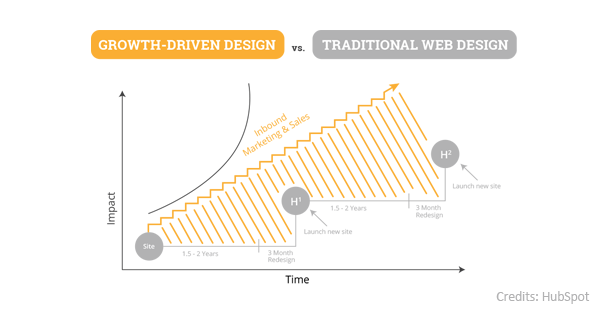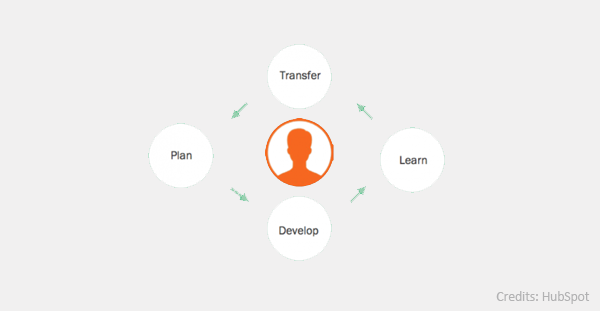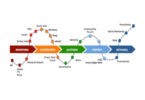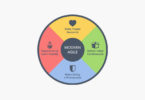Have you ever worked on the redesign of a website? How did you set the process when the website size was extensive? How often the client didn’t end up with the results expected in terms of website performances?
Whatever your role could be in marketing, account or project management teams, I guess your memories brought up headaches, challenges, unreliable and inconsistent results.
Now breathe a sigh of relief, there is good news for you: a pretty recent approach is able to help you facing the issue and ditching the broken traditional web design process. It’s called Growth Driven Design [GDD], which is an agile approach applied to the website development process able to minimise risks and drive optimal results using data and making changes based on your ongoing analysis of visitors’ needs and your lead conversions.
GDD is a course offered by the HubSpot Academy and has two sets of training and certifications: one is dedicated to digital agencies, while the other is dedicated to individuals. The latter lasts just around 4 hours and I successfully attended it in April 2018.
Uncovering the approach through this video course changed completely my perspective on website redesign and development making it even more deeply connected with user journeys mapping and the strategy phase both needed to build a compelling and result driven website. Unfortunately, I had no chances yet to fully apply it into my daily work, but I can’t wait to test it and try to customise it based on my future projects’ goals. I think it goes well also with the Modern Agile methodology, so I can’t be more excited 🙂

Growth Driven Design is an Agile and Lean approach focused on Performance Optimisation
The GDD methodology combines lean and agile principles into a highly effective data-driven web design process. Its goal is to build a peak performing website getting something valuable out the door as soon as possible rather than wait two years before launching a new website. Once you have launched the pad, you start to test, iterate and keep making tweaks to drive better and stronger results for your clients.
We can say, the process is:
- Agile, because it is an iterative and collaborative process for deconstructing complex projects with high uncertainty into bite-sized chunks
- Lean, because the thinking mindset eliminates waste, reduce risk, maximise efficiencies keeping in mind the goal to maximise value for the customer applying the build-measure-learn loop
While traditional website redesign very often involves a leap of faith in the dark, being based on assumptions and opinions that are not tested and can easily get unpredictable results, with GDD you are investing in hypothesis testing and ultimately in the growth of your business.
In fact, GDD can be defined also as a tool stack, integration of multiple tools able to add value and drive results collecting data and supporting smarter choices. The approach consists in designing websites content considering information usefulness and stickiness, tailoring messages to the targeted personas and keeping in mind constantly UX and conversion rate optimisation.

The Growth Driven Design approach in practice: phases and cycle
Let’s take a look at how this happens in practice. GDD consists of many different processes occurring in order but then in a cycle, which is key to get a successful and peak performance website.
Phase 1 consists of two stages: Strategy stage and Launch Pad stage which can be summarised as Planning stage, the first, and Development stage, the latter.
The Strategy step lasts 10 to 14 days and allows to set smart goals, understand user behaviour, solve design problems, and connect the website with its customers.
First, you start working on brainstorming ideas and wishlisting elements you would like to change, then you prioritise and deprioritise action items in the process identifying the core 20% of items that will make 80% of the impact. Each action item should be related to hypothesis statements looking back to goals and personas focus: this will help you develop an empathetic understanding of your audience’s world and how the website can solve problems along their journey constantly trying to understand their emotions, desired outcomes, and challenges.
Once you have a clear plan you can start developing in the Launch Pad stage which lasts 60-90 days: now you quickly build a website that looks and performs better than what you have today but is not a final product. Rather, your launch pad is the foundation on which to build and optimise from.
Phase 2 can be defined as the GDD cycle or the Continuous Improvement stage. With a launch pad site live and collecting user data, you can start identifying the high-impact actions you can take to grow your business, actions to be implemented in the following sprints lasting 14-day each. As your business grows and evolves, data-driven optimizations will result in a peak performance website. In this stage, learning and transferring knowledge gained through the process is crucial.
Easier said than done? Maybe, but it seems as though this approach is really able to get you far better results than a traditional one and it’s really worth the effort.
Main takeaways of the HubSpot course
There are loads of strategies and tactics ideas you can gather from this course and most of them will depend on the department you are working in. My main takeaways are mostly related to marketing and general business needs, and can be summarized as follow:
User Journey mapping rulez: Personas are the engine of the process and understand them is a must. The key concept is that “We don’t know all the answers while the users do”: quantitative, qualitative and observational research are all crucial in GDD. Specifically, user interviews are essential to understanding challenges, friction points, and gaps, mapping goals and related metrics, mapping desired outcomes to revisit the journey maps and creating mini-journey maps, talking to multiple sets of users, asking also about competitors and alternatives, digging deep into follow-up questions.
UX and CRO are best friends: GDD can help you build your website optimization roadmap being sure UX and performances (read KPIs) are elements that need to be aligned and optimized alongside each other. User Experience can be tailored as much as possible to improve CRO eliminating friction and reducing steps in the funnel. You can generate continuous improvements for your website and your business through hypothesis testing when you are able to better track results and show improvements in ROI. For example:
- Hypothesis: it’s not ideal to provide the same experience to everyone. How much personalisation could improve your CR?
- Plan: provide a hyper-relevant experience for each user within a specific user segment.
- Start to test and track results. If it doesn’t work restart the cycle. If it works, well done you can now move to the next hypothesis or make tweaks to this feature to get better results! 😉
GDD can get great results in multiple areas of the business: the website is not just a marketing tool but should serve the entire company and work as a tool able to accelerate all other KPIs metrics of the business. For example, you can think about expanding the website to the work of other teams, helping them to scale and achieve their goals:
| Team | Goal/Metric | Tactics |
| Sales | Increase close rate % | Develop sales enablement material and tools for the sales teams |
| Human Resources | Increase the monthly qualified candidates | Build a remarkable career section |
| Customer Care | Decrease monthly support tickets | Launch help sections |
Documentation and Learning are crucial: once you have gathered data and results you should share your findings within your team and with other teams: hosting team retrospective, reflect on action items asking if the hypothesis was correct and why and why not, what we learned about the users, etc. It will be also important to transfer the learning into a shared platform and organise company-wide collaboration meeting to restart the cycle efficiently and boost collaboration between teams.
To close I want to provide you one video where Luke Summerfield, teacher of the HubSpot course discussed here, compares traditional websites redesign with GDD explaining the core concepts of this effective methodology able to drive growth deeply intertwining development, user research and inbound marketing strategies.
Looking forward to putting into practice this approach? Have you already tested it? How did it go? Let me know your thoughts and feedback!








Leave a Comment